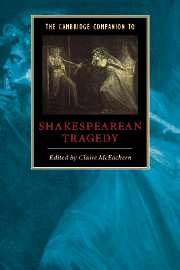Book contents
- Frontmatter
- 1 What is a Shakespearean tragedy?
- 2 The language of tragedy
- 3 Tragedy in Shakespeare’s career
- 4 Shakespearean tragedy printed and performed
- 5 Religion and Shakespearean tragedy
- 6 Tragedy and political authority
- 7 Gender and family
- 8 The tragic subject and its passions
- 9 Tragedies of revenge and ambition
- 10 Shakespeare’s tragedies of love
- 11 Shakespeare’s classical tragedies
- 12 The critical reception of Shakespeare’s tragedies
- 13 Antony and Cleopatra in the theatre
- Select bibliography
- Index
- Series List
11 - Shakespeare’s classical tragedies
Published online by Cambridge University Press: 28 May 2006
- Frontmatter
- 1 What is a Shakespearean tragedy?
- 2 The language of tragedy
- 3 Tragedy in Shakespeare’s career
- 4 Shakespearean tragedy printed and performed
- 5 Religion and Shakespearean tragedy
- 6 Tragedy and political authority
- 7 Gender and family
- 8 The tragic subject and its passions
- 9 Tragedies of revenge and ambition
- 10 Shakespeare’s tragedies of love
- 11 Shakespeare’s classical tragedies
- 12 The critical reception of Shakespeare’s tragedies
- 13 Antony and Cleopatra in the theatre
- Select bibliography
- Index
- Series List
Summary
As twenty-first-century readers, when we approach the five tragedies that Shakespeare set in the Greco-Roman world – Titus Andronicus, Julius Caesar, Antony and Cleopatra, Coriolanus, and Timon of Athens – we must negotiate among several kinds of cultural and historical differences. A striking moment in Antony and Cleopatra exemplifies the challenge these plays pose for us. In the wake of Antony's death and the victory of his arch-rival Octavius, Cleopatra imagines herself a captive in Rome, chief trophy amongst the victor's spoils:
The quick comedians
Extemporally will stage us and present
Our Alexandrian revels; Antony
Shall be brought drunken forth, and I shall see
Some squeaking Cleopatra boy my greatness
I'th'posture of a whore.
(5.2.215–20)The Egyptian queen pictures this public display in the terms of Elizabethan theatre, her feminine role performed by a boy; strictly speaking, Shakespeare has created an anachronism. Her theatrical imagery also peers into the future, as it were, reminding us that this play has in fact been staged countless times since Shakespeare penned these lines. His play lives on in our own cultural present, in film and popular culture as well as onstage.
- Type
- Chapter
- Information
- The Cambridge Companion to Shakespearean Tragedy , pp. 204 - 223Publisher: Cambridge University PressPrint publication year: 2003



